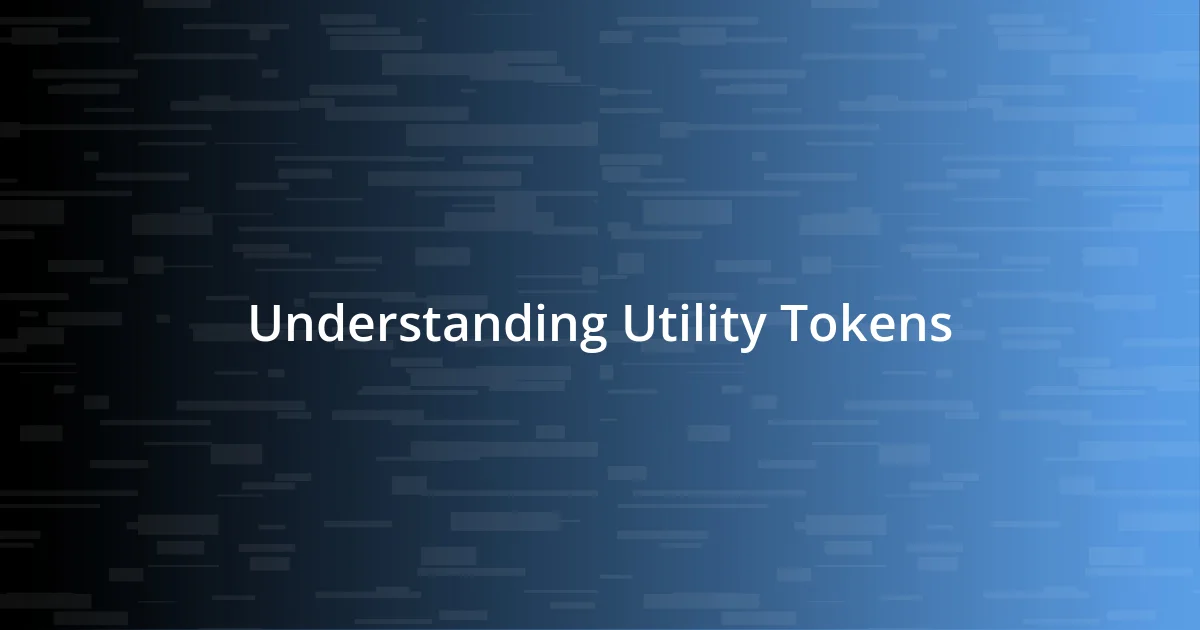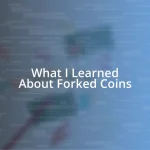Key takeaways:
- Utility tokens empower users by providing access to exclusive features and fostering a sense of community involvement beyond mere investment.
- Key utility features to assess include access to services, governance rights, transaction use cases, and incentives for holding tokens, all of which inform their true value.
- Regulatory factors and market sentiment significantly impact a token’s potential, making it crucial for investors to stay informed and analyze long-term implications for innovation and investment decisions.

Understanding Utility Tokens
Utility tokens serve a specific purpose within a blockchain ecosystem, enabling users to access a service or participate in a project. When I first dived into the world of utility tokens, I was struck by how they empower users beyond mere investment. Instead of just buying and holding, I realized these tokens often act as keys that unlock exclusive features within a platform, which adds a layer of excitement to the whole experience.
Think about it: Have you ever wished you could access premium content or special features on a platform? That’s precisely what utility tokens can provide. My discovery of a utility token that allowed me to access exclusive webinars really opened my eyes to their potential. Suddenly, they weren’t just digital assets; they became valuable tools that enhanced my learning and engagement within a community.
One of the fascinating aspects of utility tokens is their ability to create a sense of belonging. When I purchased tokens for a decentralized application, I felt like I was part of something bigger. It’s that emotional connection that highlights the importance of understanding how these tokens function within their respective ecosystems. How often do we think about not just what we invest in, but the experiences and communities we can engage with as a result?

Identifying Key Utility Features
Identifying the key utility features of a token can significantly change how I view its value within the broader ecosystem. For instance, I remember exploring a gaming platform where utility tokens allowed me to unlock characters and gain special abilities. This transformative aspect of the tokens made me appreciate not just their financial value but the enhanced experience they provided. It reinforced my belief that understanding the features of a utility token is crucial to recognizing its true worth.
When assessing utility tokens, I focus on a few essential features:
- Access to Services: Does the token provide entry to unique services or content?
- Governance Rights: Can token holders participate in decision-making?
- Consumption Use Cases: How does the token facilitate transactions within the ecosystem?
- Incentives for Holding: Are there rewards for maintaining the token instead of trading it immediately?
These features collectively paint a clearer picture of what a utility token offers, guiding my investment decisions. By honing in on these specific aspects, I feel more equipped to evaluate a token’s overall impact and potential benefits.

Evaluating Token Use Cases
When evaluating token use cases, I find it fascinating to analyze how different projects leverage their utility tokens. For example, I remember the time I explored a decentralized finance project where users earned tokens through liquidity provision. This experience not only increased my understanding of the platform but also helped me appreciate the long-term benefits of holding those tokens—rewards and potential appreciation in value over time. It made me realize that utility tokens are more than just access keys; they can also foster active participation in a community.
Another aspect I consider is the token’s integration into existing systems. In one instance, I engaged with a marketplace that utilized its tokens for transaction fees and special discounts. This dual functionality provided tangible benefits, which deepened my emotional connection to the token. It’s rewarding to feel that my engagement with the token directly translates into savings and enhanced experiences within the platform.
Moreover, I often find myself wondering about the future scalability of a token’s use case. A project I followed offered tokens that could be utilized across multiple applications, creating an ecosystem of services. This seamless interoperability sparked my imagination about the potential for widespread adoption. When evaluating a token, I ask myself: does this use case have room to grow? The answers I derive not only inform my investment choices but also contribute to a broader understanding of the technology.
| Use Case Category | Description |
|---|---|
| Access Rights | Tokens that grant users access to specific content or features. |
| Incentives | Tokens that provide rewards for holding or using within the ecosystem. |
| Community Engagement | Tokens that foster participation and governance within the network. |
| Interoperability | Tokens that can be used across multiple platforms, enhancing versatility. |

Analyzing Market Demand Dynamics
Understanding market demand dynamics is essential when analyzing utility tokens, as it helps me grasp how external factors play a role in a token’s value. I recall the excitement I felt when I first noticed a project experiencing a surge in user adoption, which inevitably drove its token price upward. It made me wonder: what causes such shifts in demand? Is it the innovative features, market trends, or perhaps the buzz created by community engagement?
One vital element I consider is how surrounding market sentiment influences demand. For example, during a cryptocurrency boom, I observed that tokens associated with promising projects often gained traction faster, regardless of their true utility. This phenomenon taught me that while intrinsic value is crucial, perceived value—shaped by public sentiment—can significantly impact demand. Reflecting on my experiences, I can’t help but ask myself: how can I remain objective amidst such hype while still recognizing promising opportunities?
Furthermore, I find it invaluable to analyze the competitive landscape. In one instance, I tracked two similar utility tokens: one was gaining traction quickly, while the other seemed to stagnate. What stood out to me was the active marketing and community-building around the first token, which fueled its demand. It made me realize that understanding market demand is not just about metrics; it’s about engaging narratives and how a project positions itself within its ecosystem. Have you ever considered how storytelling affects demand? It’s an often-overlooked aspect, but it can truly set a token apart in a crowded market.

Assessing Team and Development Progress
When it comes to assessing team and development progress, I often focus on the team’s background and expertise. I remember a particular instance when I attended a conference and met the developers behind a groundbreaking gaming token. Listening to their passion and deep understanding of both gaming and blockchain technology immediately bolstered my confidence in their project. It’s amazing how a team’s credibility can heavily influence my perception of a token’s potential.
Another critical aspect is the transparency of the team’s communication and updates. I’ve followed projects where the team frequently shared development progress through social media and community forums. There was one project that even hosted weekly live Q&A sessions. This openness not only kept the community engaged but also gave me reassurance that the team was dedicated and accountable. Wouldn’t you agree that consistent communication fosters trust?
Lastly, I like to evaluate how well the team adapts based on user feedback and market changes. There was a project I observed that initially launched with a simple use case but then responded to user needs by adding more functionalities. This responsiveness surprised me and made me consider what it reveals about the team’s commitment to its ecosystem. Sometimes, a team’s ability to pivot shows they genuinely care about user experience. Have you ever thought about how a team’s responsiveness can be a significant indicator of their success? It’s a crucial part of my analysis that shapes my investment decisions.

Considering Regulatory Factors
When considering regulatory factors, I often reflect on how regulatory frameworks can profoundly affect utility tokens. For instance, I remember attending a webinar where a legal expert highlighted how changes in regulations can either bolster or hinder a token’s market potential. It made me realize that staying informed about regulatory developments is not just about compliance but essential for strategic investment decisions. Have you ever wondered how those shifts might affect your own investments?
Another aspect I pay attention to is the classification of tokens. Is it a utility token or a security token? This differentiation can significantly impact how a project operates and raises funds. I once invested in a token that was initially classified as a utility token, but regulatory scrutiny later placed it under the security banner. The consequent market reaction was drastic, and it taught me a vital lesson: always dissect the token’s regulatory environment. The fine line between utility and security can mean the difference between a booming project and a regulatory nightmare.
Lastly, I actively consider the long-term implications of regulation on innovation within the ecosystem. I recall discussing with friends how strict regulations in certain jurisdictions stifled creativity and growth for budding projects. It’s fascinating how a supportive regulatory environment can foster innovation, while harsh regulations could push talented teams to operate in more flexible jurisdictions. Have you thought about how these regulatory factors could influence the overall growth of the blockchain space? It’s a crucial piece of the puzzle that could dictate not only individual investments but also the future of the technology itself.

Making Informed Investment Decisions
When making informed investment decisions, I often find myself reflecting on the broader market sentiment. I clearly recall a time when I was torn between investing in two promising tokens, both boasting solid use cases. However, I noticed one project had overwhelming community enthusiasm, while the other seemed to lack engagement. That experience taught me how important it is to listen to the chatter around a token; it often serves as a pulse check for its potential. Have you ever relied on community sentiment to guide your choices?
Another aspect I prioritize is the project’s roadmap and milestones. I once invested in a token that had laid out an ambitious plan but failed to hit key deadlines. The subsequent dip in confidence among investors was palpable. It’s essential to analyze whether the team is realistic in their goals and transparent about progress. I believe that consistent, honest updates can make or break trust with the investor community. How often do you revisit project roadmaps in your analysis?
Furthermore, I consider the token’s utility and real-world application. I remember being excited about a token that promised a revolutionary approach to supply chain management. However, as I dug deeper, I realized the project had not secured partnerships that would make their vision a reality. This experience underscored for me the necessity of examining not just the concept but also the tangible impact it can make. Have you ever been thrilled by a project only to discover it was more hype than substance? That’s a lesson I now carry into every investment decision I make.














